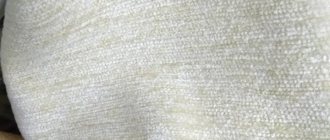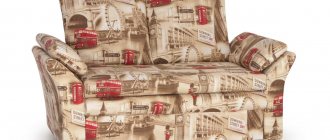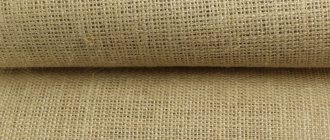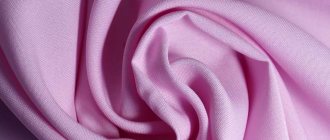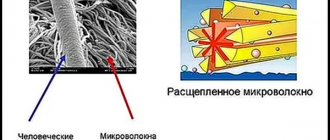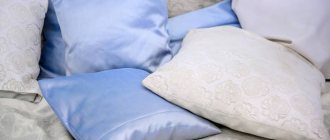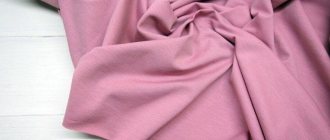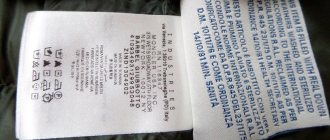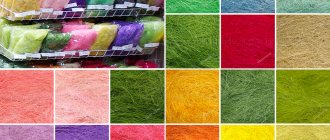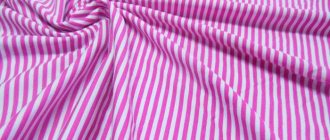Chenille is a dense, wear-resistant material with a pleasant velvety structure. This fabric has excellent consumer characteristics: it makes durable upholstery for furniture, high-quality curtains and drapes.
This fabric began to be woven in the USA about 200 years ago. Due to the special structure of the thread, it received the name “chenille”, which is translated from French as “caterpillar”. Indeed, chenille thread, braided with fluffy fibers for strength, resembles this insect.
Fabric characteristics
Composition and production technology
Chenille thread is made in a special way: combed fluffy fibers are woven into the main smooth thread, after which the workpiece is tightly twisted, forming a thread with a dense fleecy structure. This thread is called chenille.
After twisting, the threads are dyed and sent to the weaving factory. There they are made into fabric by weaving chenille fibers into the warp threads. And the greater the number of chenille threads woven into the fabric, the denser and heavier the material will be.
In the production of chenille, both natural (cotton) and synthetic (polyester, acrylic, artificial viscose) materials are used, making the fabric durable and strong.
Properties
The weave of threads in chenille fabric can be different: satin, tapestry, twill or jacquard. The structure, appearance and consumer characteristics of the material depend on weaving. The most valuable is chenille fabric with jacquard weave.
Properties of chenille:
- does not shrink after treatment with water, but can become deformed when exposed to high temperatures;
- It is elastic, does not stretch well, does not wrinkle;
- draped in heavy, large folds;
- paints well and has a rich palette of shades, thanks to which it is very popular among designers;
- The color lasts a long time, does not rub off or fade.
Furniture with chenille upholstery looks expensive and noble. Due to the fact that multi-colored threads can be used in the manufacture of canvas, furniture covered with this material shimmers in different shades.
What is chenille
The material was created in the USA more than two hundred years ago. In the past, fabric was an expensive exclusive that not everyone could afford. Now the unique material has come into use and is available to anyone.
Chenille fabric
The name comes from the French word meaning “caterpillar”. The reason for this name is the characteristics of the fibers of the material, which consists of fluffy threads.
Huge color base of material
Types of chenille
According to its composition, chenille is divided into 3 types:
- Natural. The material contains more than 60% natural cotton fiber. It is environmentally friendly, hypoallergenic, pleasant to the touch and does not electrify. Its disadvantage is low strength.
- Artificial. The fabric is made from synthetic threads, cotton and artificial viscose. This chenille is stronger and more durable than natural, it is softer and more practical.
- Synthetic. The composition of the fabric is dominated by synthetic fibers - acrylic and polyester (more than 60%). The fabric is not very pleasant to the touch, but is durable and resistant to stains.
Chenille fabric composition
- The composition of chenille fabric varies; in natural material cotton fiber predominates, in artificial material there is a large amount of viscose, while synthetic chenille is made from polyester.
- In addition, fabrics such as satin, tapestry, as well as twill and jacquard can be used.
- The composition of chenille affects the aesthetic perception, as well as the technical characteristics and care of the fabric.
- Today, the most expensive is chenille with jacquard fiber weave.
- Density - 406 g/sq.m.
Areas of use
Chenille fabric is used in three areas:
- Furniture manufacturing. Durable fabric with a high content of fleecy threads is used for upholstery of upholstered furniture: sofas, armchairs and chairs. Products upholstered in chenille retain their beautiful appearance for a long time, do not fade or fade.
- Sewing home textiles. Curtains are made from less dense curtain chenille. Such products do not allow light to pass through, so they are often used to decorate a living room or bedroom. Often this fabric is used for blankets and bedspreads.
- Interior decor. Decorative panels are made from chenille and walls are covered with it. This material perfectly absorbs noise, does not accumulate dust and is easy to clean.
The note! When sewing clothes, chenille is rarely used due to the high density and heaviness of the products. Sometimes robes or aprons are made from it.
History of creation
Chenille fabric appeared many years ago; an exclusive technology for producing the fabric was developed in the 18th century in the USA.
The term "chenillle" is considered to be French and literally means "caterpillar". This is no coincidence, since chenille fiber looks somewhat like a caterpillar: fluffy and twisted. Thus, fluffy threads intertwining with each other create an overall structure. The production technology that was developed in America was kept strictly secret for a long time; chenille was exported from the USA to other countries of the world, which is how this fabric spread around the world. Since its mass production was not established, this fabric was quite expensive, so not everyone could afford it.
First of all, chenille was used for the production of upholstered furniture, namely for the upholstery of sofas, as well as armchairs and chairs. Thanks to this, the material has a very reliable, strong and durable structure. Wear resistance is considered one of its most important advantages. At first, the entire technological process was carried out only by hand; this slowed down the spread and availability of chenille fabric, so only high-ranking and wealthy people could afford upholstered furniture with upholstery made from this material.
Over time, the production of chenille has been optimized; machines specializing in the production of this fabric have appeared, which has reduced costs and reduced the cost of the fiber itself. Currently, chenille is still in demand and relevant in the manufacture of furniture and sewing curtains; the material can skillfully transform the interior of any apartment.
Advantages and disadvantages
Advantages of the material:
- natural chenille is environmentally friendly and hypoallergenic;
- paints well, does not lose color over time, does not fade or rub off;
- has a pleasant velvety structure, reminiscent of corduroy to the touch;
- synthetic fabric is durable, wear-resistant, practical;
- It is cheaper than popular upholstery materials (for example, velor), but is not inferior to them in beauty.
Minuses:
- natural fabric absorbs water well, so it gets dirty easily;
- requires dry cleaning without the use of aggressive cleaning agents;
- the fabric is prone to snags: threads are easily pulled out when exposed to sharp objects.
Advice! If you have pets, you should not buy furniture with chenille upholstery. Sharp claws of pets will quickly ruin the canvas.
Furniture chenille: current design and fashionable colors
At the moment, this type of fabric is on the list of the most relevant, stylish and expensive materials. Production technologies allow us to create unique, original colors.
Curtains
Now the trend is chenille for furniture with:
- Solid colors, burgundy is especially popular.
- Abstract drawings.
- Damask patterns on light, cream backgrounds.
- Geometric motifs.
You may be interested in what fabrics are used for sewing bed linen
Fabric with abstract patterns
Care
Chenille products require special care:
- stained fabric requires careful dry cleaning or professional dry cleaning;
- It is not recommended to wash fabric or remove dirt from it with aggressive detergents: it is better to use a vacuum cleaner or brush;
- to remove the stain, you can use a stain remover for upholstery fabrics;
- It is not advisable to place chenille products near hot radiators or heating devices, as the fabric may become deformed;
- It is not recommended to iron the material.
Advice! Newly appeared stains on the surface of the fabric can be removed with a small amount of soapy water. You need to mix liquid soap with water in a 1:1 ratio, apply this composition with a brush to the fabric, and after drying, vacuum it.
Video: comparison of furniture chenille, jacquard and tapestry
In the video, a furniture store worker compares fabrics one by one: chenille, tapestry, jacquard, flock, velor, matting, suede and faux leather.
See similar articles
- Diving - close-fitting viscose fabric
- Modal - lightweight cellulose fabric for linen and clothing
- Neoprene is a warming and durable waterproof material
- Fabric for making a coronavirus mask with your own hands
- Crepe georgette is a translucent fabric with a grainy texture.
- Organza is a thin fabric for elegant clothing and interior design
If you liked the article, share it with your friends!
Handwash
Fluffy chenille fabric needs very careful washing. Otherwise, its main advantage - fluffy pile - will lose its unique properties.
For example, chenille curtains can be washed by hand if it is not possible to dry clean them. At the same time, the water temperature should not be higher than 40°C, otherwise the canvas will “shrink” and lose its presentation.
The stain can be pre-treated as follows:
- Blot fresh stain with a dry, clean cloth
- Apply a solution of soapy water to the dirt and gently rub it with a soft sponge or brush
After treating the stains, soak the fabric for 30-60 minutes, then wash.
Handwash
You can hand-clean chenille only as an exception, and if the composition is dominated by artificial or acrylic fiber.
If in doubt, it is better to take the item to the dry cleaner.
Detergents
To clean chenille from dirt, you can use only products specifically designed for this type of fabric, or use traditional methods:
- To remove spot dirt and stains: use a solution of ordinary soap and water, a solution with ammonia (3-6%). After blotting the stain with a clean napkin, apply the solution to the desired area and wipe with a soft brush or sponge.
- To dry clean the surface of the product and eliminate local contamination, use sprays specially designed for cleaning chenille. Apply to the stain, wait 2-3 minutes. The active substances in the product will attract pollution. Wipe the textile with a sponge or napkin.
Washing in a washing machine
When deciding to machine wash a chenille item, you need to be aware of all the possible consequences. Chenille can shrink, lose its shape and its inherent shine. The pile may lose its volume and settle.
ARTICLE FOR YOU
How to wash rip stop items: in the washing machine and by hand
Washing chenille curtains in laundry bags
Machine cleaning is possible using the most gentle mode (hand wash, wool modes), at a temperature of 30-40°C. The washing time is usually set automatically - from 40 minutes to 1 hour.
Never use bleach or other chemicals. Wash separately from colored items.
